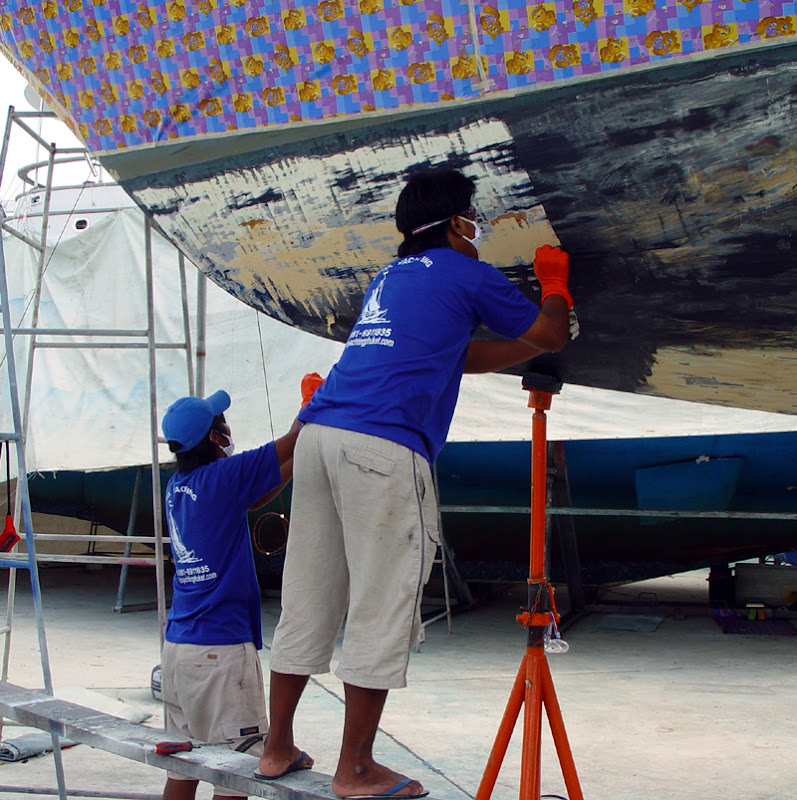 You might ask who chose that delightful new colour scheme - hey everyone else is ! Truth is, we're six weeks into refit and starting to deal with the "unexpected". That is PVC floor covering taped over the topsides to protect them during the sand blasting. Woops....
You might ask who chose that delightful new colour scheme - hey everyone else is ! Truth is, we're six weeks into refit and starting to deal with the "unexpected". That is PVC floor covering taped over the topsides to protect them during the sand blasting. Woops....Soon after hauling the boat from the water we noticed a reasonable number of small blisters under the waterline - we'd seen them before, as they started appearing about 5 years ago. The last few times I've
 spent a few days grinding them back and rebuilding the base epoxy coat on the steel. Whilst it only affected small areas, it was a real pain in the ***.
spent a few days grinding them back and rebuilding the base epoxy coat on the steel. Whilst it only affected small areas, it was a real pain in the ***.This time things were more serious - they've been breeding ! So we called in Jimmy Watt from Siam Surveyors, a local and knowledgeable marine surveyor. Jimmy scraped a couple back and offered a depressing explanation. It seems that the last time we sand blasted right back to bare metal below the waterline (at Harwood Slipway in NSW), there was possibly a malfunction somewhere - oil droplets were probably sprayed onto the hull, most likely from a leaky seal in the compressor. Where was the oil
 filter in the line I ask ? These small droplets of oil were effectively propelled onto the steel and then the epoxy coat was sprayed over the top. The result is that the epoxy is now releasing from the surface, where the oil interfered with the adhesion. Its easy to see the splatter pattern of the oil droplets when you look at the partially sanded hull - the blisters clearly occur in obvious groupings.
filter in the line I ask ? These small droplets of oil were effectively propelled onto the steel and then the epoxy coat was sprayed over the top. The result is that the epoxy is now releasing from the surface, where the oil interfered with the adhesion. Its easy to see the splatter pattern of the oil droplets when you look at the partially sanded hull - the blisters clearly occur in obvious groupings.Some areas of the hull have almost none, whilst in other areas the groupings are depressingly frequent. Coincidentally, we have good friends sailing a beautiful composite hulled yacht whose steel keel has been exhibiting similar blistering. Guess what - that keel was blasted by the same contractor around the same time. Oops.

In the end we decided to sand blast the hull again - something we thought we'd put behind us. Pro-Yachting offered a revised contract price to include the necessary work, and we found we could blast the hull clean here in Phuket for a very reasonable cost. We had no hesitation in accepting the proposal. To minimise the blasting time, the Pro-Yachting team started with paint stripper and scrapers - a team of five guys worked for 2 weeks, working there way through 14 one gallon cans of paint stripper. Back braking work.
For the past 10 days they've been blasting and priming, working their way along each side of the hull and keel. It is slow, dirty, noxious and tedious work, but we're impressed with their dedication and attention to detail. The blasting and priming are now finished - we have one coat of zinc rich epoxy (Jotun Barrier 77) and two coats of high build protective epoxy (Jotamastic 87).
 Incidentally, we also asked the surveyor to test and inspect Crystal Blues hull, as she's almost 20 years old now. So Jimmy used his ultrasound testing equipment to survey the plate thickness. He checked all the likely "weak spots" - bottom of the fuel tank, the chain locker, bottom of the rudder, shaft log area, as well as numerous random samples. Whilst he did find two tiny pinholes (welding faults) he also said it was one of the best survey results he'd seen for a steel yacht. Happiness is a sound hull ! Jimmy has also shown us that she's built of Cor-Ten steel, something we did suspect but could not confirm. Cor-Ten steel is a step up from standard mild steel - stiffer and more corrosion resistant - some good news to balance the bad stuff.
Incidentally, we also asked the surveyor to test and inspect Crystal Blues hull, as she's almost 20 years old now. So Jimmy used his ultrasound testing equipment to survey the plate thickness. He checked all the likely "weak spots" - bottom of the fuel tank, the chain locker, bottom of the rudder, shaft log area, as well as numerous random samples. Whilst he did find two tiny pinholes (welding faults) he also said it was one of the best survey results he'd seen for a steel yacht. Happiness is a sound hull ! Jimmy has also shown us that she's built of Cor-Ten steel, something we did suspect but could not confirm. Cor-Ten steel is a step up from standard mild steel - stiffer and more corrosion resistant - some good news to balance the bad stuff.
No comments:
Post a Comment
Have something to say ? Let us know your thoughts ....